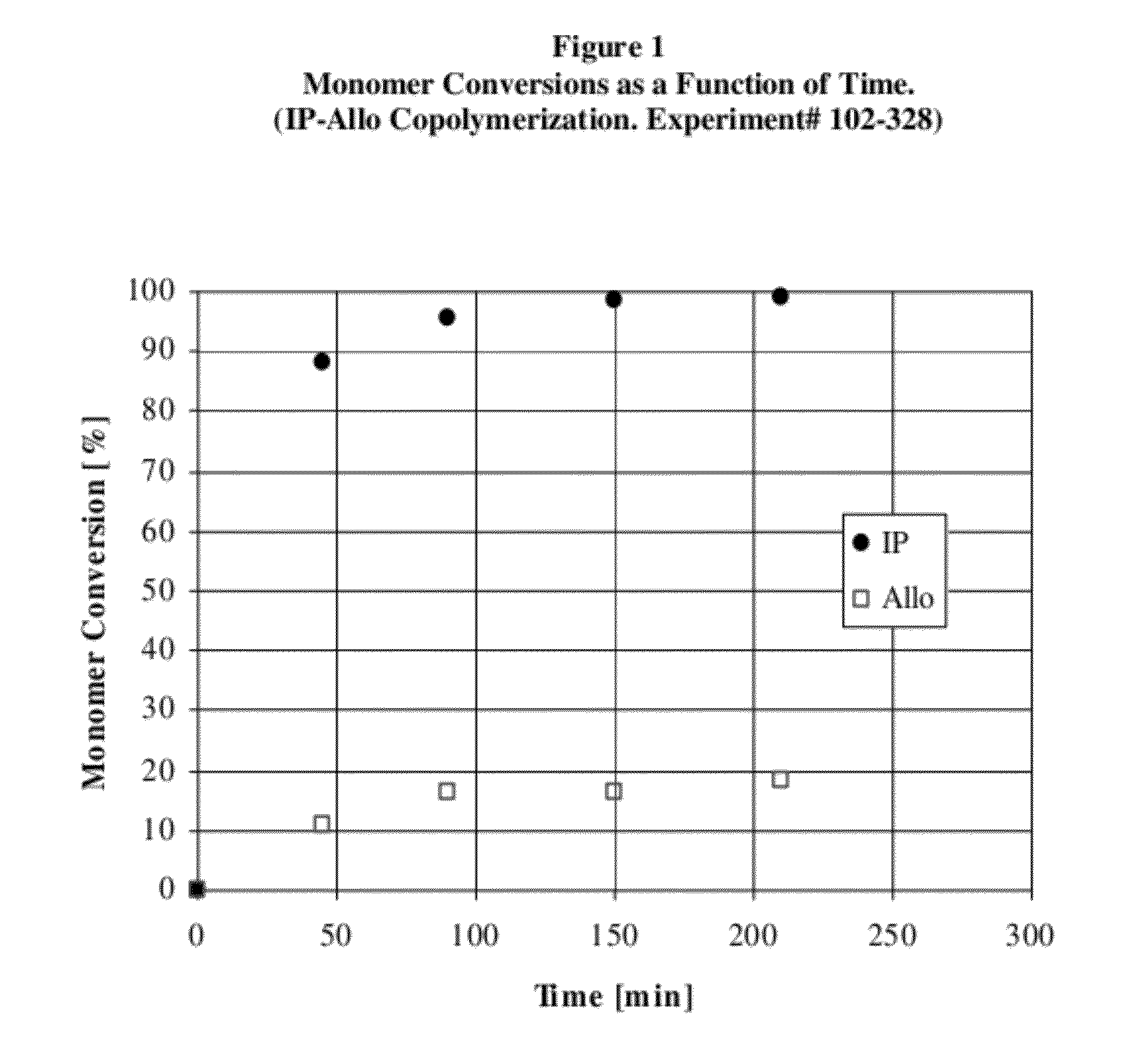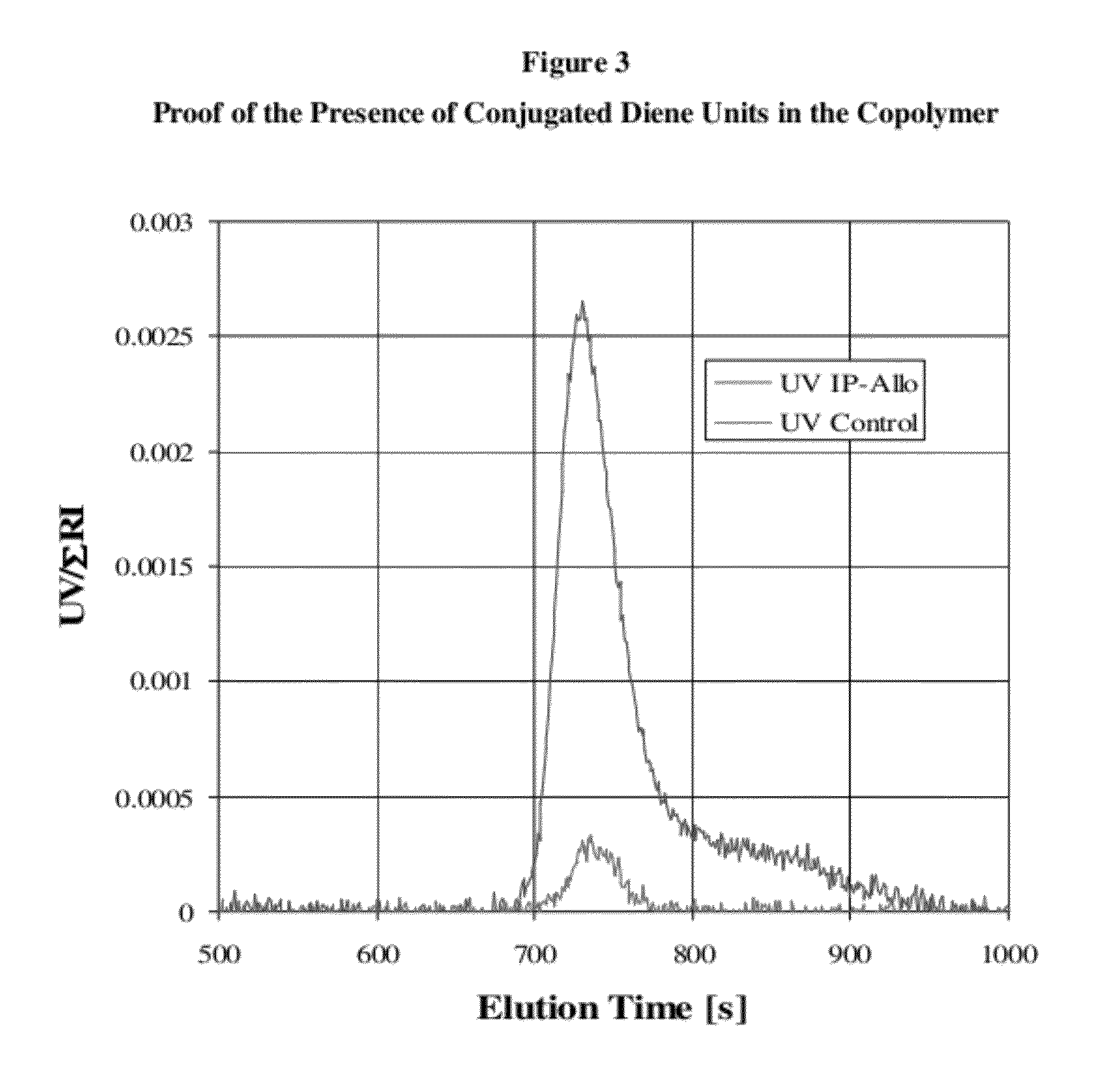Copolymers of conjugated triene monomers for improved filler interaction
a triene monomer and conjugated triene technology, applied in pneumatic tyre reinforcements, tire parts, vehicle components, etc., can solve the problems of lower hysteresis value and lower rolling resistance of tires made therefrom, and achieve superior reinforcement and increase the effect of filler interaction
- Summary
- Abstract
- Description
- Claims
- Application Information
AI Technical Summary
Benefits of technology
Problems solved by technology
Method used
Image
Examples
example 1
[0128]In this experiment alloocimene was copolymerized with isoprene monomer to make an isoprene-alloocimene copolymer rubber. In the procedure used hexanes (Ashland, Polymerization Grade) was recirculated through silica gel for 4 hours before use. Isoprene (Li Grade) was distilled before use and n-butyllithium (Aldrich, 1.6 M solution in hexanes) was used as received. The alloocimene (Allo) monomer, 2,6-dimethyl-2,4,6-octatriene, from Aldrich (technical grade 80%, CofA GC purity 95.6%) was passed through an aluminum oxide column (Aldrich, neutral, Brockmann I activity), purged with nitrogen and stored over calcium hydride (Aldrich, reagent grade, coarse granules, 2.
[0129]SEC measurements were conducted using a Polymer Laboratories PL-GPC 50 Plus system equipped with four detectors (45 and 90 degree laser detectors (650 nm wavelength), RI and UV detectors) and two Mixed-C columns (5 μm Mixed-C PL-gel 300×7.5 mm). The mobile phase was THF at 1 mL / min flow rate. Measurements were done...
example 2
[0141]In this experiment, butadiene / alloocimene copolymer was synthesized along with a polybutadiene control polymer and both polymers were characterized and compared. In the procedure used, Hexane (Ashland, Polymerization Grade) was recirculated through silica gel for 4 hours before use. Butadiene was received from Exxon. It was distilled to remove the stabilizer and heavies before use. n-Butyllithium (Aldrich, 1.6 M solution in hexanes) was used as received. 2,6-Dimethyl-2,4,6-octatriene (Aldrich, technical grade 80%, CofA GC purity 95.6%) was passed through an aluminum oxide column (Aldrich, neutral, Brockmann I activated), purged with nitrogen and stored over calcium hydride (Aldrich, reagent grade, coarse granules, 2.
[0142]SEC measurements were conducted using a Polymer Laboratories PL-GPC 50 Plus system equipped with four detectors (45 and 90 degree laser detectors (650 nm wavelength), RI and UV detectors) and two Mixed-C columns (5 μm Mixed-C PL-gel 300×7.5 mm). The mobile ph...
example 3
[0160]This example illustrates that silica reactive functional group such as triethoxysilane can be attached to the IP / Allo copolymer via Diels Alder reaction. The chemical strategy envisioned is illustrated by Scheme 3. The reactions were carried out in a single mix cycle using stepwise addition of chemicals. For the reaction equimolar maleic anhydride (MAnh) and 3-aminopropyltriethoxysilane (APT) were used. Amounts were set at 1 mol % to the isoprene content of the copolymer containing 0.27 mol % incorporated Allo units.
[0161]First the copolymer and maleic anhydride (MAnh, 1.44 phr) were added to the mixer which was preheated to 130° C. These were mixed for 2 minutes using 60 rpm rotor speed. Subsequently a mixture of silica (65 phr) oil (20 phr) and 3.26 phr APT was added and mixing was continued for 6 more minutes. Subsequently, the compound was pressed to a sheet and remixed using the same conditions and 3 minutes mixing time. A compound was also made using the IP / Allo copolyme...
PUM
| Property | Measurement | Unit |
|---|---|---|
| weight percent | aaaaa | aaaaa |
| weight percent | aaaaa | aaaaa |
| weight percent | aaaaa | aaaaa |
Abstract
Description
Claims
Application Information
 Login to View More
Login to View More - R&D
- Intellectual Property
- Life Sciences
- Materials
- Tech Scout
- Unparalleled Data Quality
- Higher Quality Content
- 60% Fewer Hallucinations
Browse by: Latest US Patents, China's latest patents, Technical Efficacy Thesaurus, Application Domain, Technology Topic, Popular Technical Reports.
© 2025 PatSnap. All rights reserved.Legal|Privacy policy|Modern Slavery Act Transparency Statement|Sitemap|About US| Contact US: help@patsnap.com



